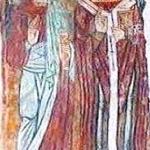Performing Identity through Magical Clothing
Special clothing and magical tools enhance the theatricality of Witches’ rituals, but they also help unlock the participants’ mental states. Sabina Magliocco, folklore scholar, explains, “The physical acts of putting on costumes and taking up props are also important cues for some Pagans . . . through them, participants can literally take on new identities” (Witching Culture, 173). In “muggle” (nonmagical) life, a Witch cannot easily be distinguished from a non-Witch by clothing. In general, Witches look like everyone else. While Witches may be teachers or bankers or social workers in the mundane world, when they don ritual garb, they become Priestesses and Priests. “For Neo-Pagans, ritual dress (and undress) mark the shift from everyday reality to ritual reality” (Magliocco, Sacred Art, 53). The costumes act like keys to unlock this alternate identity, along with other states of mind.
Just as costumes for a theatrical production never appear on stage by accident, a Wiccan chooses clothing very specifically for the psychological and spiritual messages that clothing gives to the self and others. Ritual clothing for Wiccans takes many forms based on tradition. Gerald Gardner taught that ritual should be done naked, commonly called “skyclad,” and some Witches continue this practice. Some groups wear specific ritual robes, while others are more eclectic in their choices:
Medieval and pre-Raphaelite looks predominate, with a dose of Viking and Hollywood Egyptian elements . . . Long hair is common for both men and women, and many Pagan men favor beards; everyone wears lots of black, a color traditionally associated with witches in European folklore. Both women and men wear necklaces and pendants in multiples; body paint and tattoos are not uncommon. The overall general effect is one of loose, gentle roguishness. (Magliocco, 54)
The Medieval and pre-Raphaelite clothing suggests a world of fantasy, a world filled with Lords and Ladies (which also reflects the titles given to Wiccan Deity). Many Witches also participate in organizations where they can dress historically, like the Society for Creative Anachronism and Renaissance Festivals, as they enjoy these styles. All colors have specific correspondences, depending on the tradition, so colors may be chosen for specific magical workings, but black is a “universal” color used to repel negativity in many magical systems. Necklaces, pendants, body paint, and tattoos all allow individuals to choose and display personal symbols. Sometimes entire groups wear matching pendants or tattoos as a method of group solidarity.
At large Neo-Pagan festivals or gatherings, the variety of costuming provides much of the festival environment and allows Witches to perform their religious identity. According to Magliocco, “The development of special ritual clothing parallels the expansion of Paganism beyond Gardnerian Craft and the growth of a public festival culture where aspects of Pagan identity and affiliation can be performed” (56). For the practitioners, costumes “mark the boundary between the everyday world and the heightened reality of the festival environment” (36). Many Witches have entire closets full of clothes they would never wear in their “muggle” lives. These may include specific ritual robes, but they also may include more fantastic costume elements like fairy wings, wearable horns (for men and women), and even the stereotypical pointed witch hats. Sarah Pike, in her study of Neo-Pagan festivals, explains, “Neopagans create images of festivals as magical worlds out of the mythological stories, fantasy, and science fiction that many of them have loved since childhood” (231n). Witches choose how to enact their “magical” selves through costuming.
In choosing costumes for the first Harry Potter film and laying visual groundwork for all of the subsequent films, costume designer Judianna Makovsky used a broad spectrum of inspiration. "There's no real period," says Makovsky of the film's costumes, “which range from Elizabethan ruffs to tartan plaids to Dickensian frocks” (Cagle). The separation between muggles and the witches or wizards shows visually through the costumes in Diagon Alley, the first scene where Harry encounters groups of people from the wizarding world. In this scene people wear a variety of robes in dark, rich colors and fabrics, top hats, cloaks, and variations of the conical witch or wizard hat. Their clothing choices designate their identity as belonging to the magical world rather than the typical jeans and shirts Harry wears from the muggle world.
Witches tend to wear specific “magical” clothing when in community with other Witches, and this choice of “costume” helps create group identity. The result is an anachronistic hodgepodge of unique and interesting clothing reminiscent of Potter’s wizarding world. When I first read Rowling’s description of the campground at the Quidditch World Cup in Harry Potter and the Goblet of Fire, I laughed out loud in recognition. She describes one of the wizards as pairing a poncho and a kilt, a pairing I’ve seen in person more than once at Neo-Pagan festivals. To me and several other Wiccan readers, this description felt like an “in joke.”




